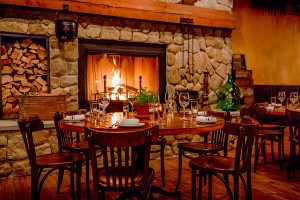Memorial Day Grilling Tips from Chef Andy Husbands

Andy Husbands. / PHOTOGRAPH BY TOAN TRINH for “Right On Cue”
Slather on the SPF 30, wash your hands, then grab a metal spatula—it’s almost the unofficial start of summer. The Memorial Day cookout is straightforward for most weekend warriors—throw a couple burgers on the grill, right? How hard can it be?
Not hard, you’re right—but it can be better. Take it from the Smoke Shop BBQ and Tremont 647 chef Andy Husbands, who’s written tomes on the subject.
“Grilling is about speed. Barbecue’s about time. With grilling, you really want to be prepared,” says Husbands.
Along with collaborator Chris Hart, Husbands has written four cookbooks, including Wicked Good Burgers. (If you’re more interested in his slow-smoking technique, keep an eye out for the duo’s latest, Pitmaster, if you’re riding the T today.) Here are the basics for making the juiciest, most flavorful burger in the neighborhood.
This advice has been edited for length and clarity.
Have all of your ingredients ready and at the grill. This will lower the chances of mistakes and burnt food. That means having your burger patties formed and seasoned.
I like to mix a little bit of salt into my burger meat before I’m forming it. I just think that way it seasons all the way through, and I definitely heavily salt and pepper it on the outside.
You want to [form the patties] with the burger meat being cold. Your hands are warm, and if you’re working in a warm environment, the fat will melt a bit, which will result in a crumbly, dry burger. So, making a burger at 3 p.m. on Memorial Day Weekend is not the ideal time to do it. I would advise you to do it inside, in the morning, and refrigerate them until you need them.
I like a half-inch, but some people like big, thick ones. When making a burger, whats important is you’re making a circular, flat disc that’s even on all sides. You don’t want it to look like a frisbee. You want the heat to come in equally.
Put a little dimple in the center, with your thumb. Maybe an eighth- to a quarter-inch, almost like you were trying to make a doughnut. A burger bows in the center [when it cooks], and this will counteract that. It will make it flat by the time it’s done cooking.
I prefer hardwood charcoal for its quick-lighting, clean burning, incredible heat. [Direct] Grilling is essentially about speed and this clean, high heat will help you get a wonderful char of your food.
The only pro I have [for using lighter fluid] is that it reminds me of biking through Needham as a child, and the smell of people lighting their grills. [Otherwise,] It’s an added expense. Secondly, it’s a chemical you’re putting on top of these coals that can flavor your food.
You can get natural hardwood charcoal, like Cowboy, at most grocery stores. All you need to do is crumple up a bunch of paper underneath the grill gate, and put the hardwood on top [of the gate]. It will light, though it will be faster with a chimney.
I would strongly advise you give [your grill] a good scrub with a grill brush before you use it. As long as you have a good, hot, clean, grill, and you give the burger a second to sear, you don’t need to oil it. That’s why we don’t eat burgers every day—they’ve got some fattiness to them. That’s what makes them yummy.
For some reason, the tides have turned [on American cheese]. I’m a big fan of letting people do what they want. I like a classic American burger, but I’m not going to say no to Brie if someone wants to do that. You want it to be thin-sliced, and the burger needs to rest. That’s a really important part of the burger cooking process. That’s what keeps it juicy.
Right before you take it off [the grill], put the cheese on, then put [the burger] on a rack and dome it with a piece of aluminum foil to melt the cheese.


